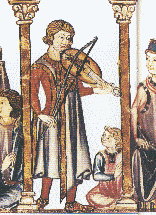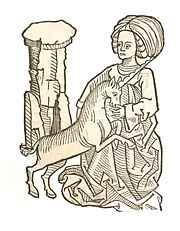Konrad von Kreuznach
Konrad von Kreuznach , Cunze von Crutznach or Conradus de Crucinaco (* in Kreuznach ; † May 31 or October 13, 1368 in Mainz ) was a German musician , perhaps also a poet ( minstrel or song poet ) in the middle of the 14th century .
Life
Master ( magister ) Konrad von Kreuznach was a famous fiddler ( "sollempnis figellator" ). Presumably he worked under Archbishop Gerlach von Nassau as ministrallus (court minstrel ) at the archbishop's court; he had a grain pension in Dexheim .
Whether he should also be considered a minstrel or song poet is disputed in research, as no poetry can be clearly attributed to him. Franz Joseph Bodmann identified in 1802 in a “ m [anu] s [crip] to coaevo ” (= simultaneous handwriting; probably a copy from the beginning of the 15th century) the Marian song “ A prince who hunted long cit… A wild unicorn "(RSM 1 Rosw / 1c) as a work by Konrad von Kreuznach, which should be sung " in long (tone) women's praise (s) ". Gotthelf Fischer von Waldheim , to whom he gave the poem, wrote it to the minstrel Heinrich von Meissen, known as Frauenlob († 1318) , when it was first published in 1803, despite his own concerns . The original manuscript from which Bodmann had concluded that Konrad was the author has been lost. In the headline of a Basel parallel tradition, the indication of origin "roswinn" appears; a song writer “Roswin” is otherwise unknown. The tradition may come from the town of Roßwein , in which in 1467 there is evidence of a Kalandsbruderschaft (a choir since 1567) that was musically active at the St. Marien Church and in 1505 owned three mass books and a "Singe book".
Konrad von Kreuznach was buried in the east wing of the cloister of Mainz Cathedral , where the minstrel Frauenlob is also buried. His tombstone was restored in 1785 by Domdechant Georg Karl von Fechenbach , but damaged again in the bombing of Mainz in 1793. It was probably removed during the renovation of the cloister in 1841–1845 and is no longer preserved today or has been built with a covered front. The medalist and coin engraver Johann Lindenschmit (1771–1845) made a drawing in 1806, perhaps on behalf of Franz Joseph Bodmann, depicting a man in religious costume with a violin under his left arm. Conrad bequeathed his fiddle worth 7 guilders , 4 groschen and 10 pelmets ( "VII flor. Quatuor grossos et X hallenses" ) to the presence of the Mainz cathedral chapter .

The gravestone bore the inscription
COS] T (it). Ø (biit). MAGIST (he). CONRADVS. DE. CRVCENACO +
In the foundation book of the cathedral, October 13th ( iij. Idus octobr. ), A Friday, is given as the day of death, the Wednesday after Whitsun 1368 was May 31st.
swell
- Fundationes et consuetudines ecclesiae cathedralis Moguntiae , 1362–1511 ( Martinus Library Mainz, Hs. 3)
- Georg Helwich : Syntagma monumentorum et epitaphiorum , around 1611–1623 (Martinus Library Mainz, Hs. 225)
- Jakob Christoph Bourdon: Epitaphia in Ecclesia Metropolitana Moguntina anno 1727 , copy of the 19th century; Mainz City Archives (13 remains of the monastery and monastery archives, 139 I); Copies also in the Martinus library, in the Episcopal Ordinariate in Mainz, in the Bavarian State Library in Munich (Cod. Lat. 10447) and in the Eltville archive of the Eltz family
Works
- (uncertain; attributed by Franz Joseph Bodmann): Im long frowenlob. A prince who hunted long cit… In: Gotthelf Fischer von Waldheim: About some monuments of old German poetry . In: ders .: Description of some typographical rarities together with contributions to the history of the invention of book printing 4 (1803), pp. 109–140, especially pp. 112–121 ( digitized version of the Bavarian State Library, Munich) (RSM-No .: 1 Rosw / 1c )
literature
- Valentin Ferdinand von Gudenus : Codex diplomaticus anecdotorum , Vol. II. No. 139, Akademische Buchhandlung Göttingen 1747, p. 894 ( digitized version of the Bavarian State Library in Munich), ( Google Books )
- Franz Falk : The Minnesinger Conrad von Kreuznach in Mainz Cathedral . In: Monthly for Rhenish-Westphalian historical research and antiquity 2 (1876), p. 459f ( digitized version of the University and State Library of Münster)
- Franz Falk: The foundation of Fiedler's Conrad von Kreuznach at the Dome in Mainz . In: Der Katholik 76/1 (1896), pp. 93–96 ( digitized in the Internet Archive)
- Franz Falk: anniversary of the death of Heinrich Frauenlob. November 29th . In: Mainzer Journal 44 (1901), No. 279 of November 30, 1901
- Rudolf Kautzsch , Ernst Neeb (arrangement): The art monuments of the city and the district of Mainz , Bd. II / 1 The cathedral to Mainz . Hessischer Staatsverlag, Darmstadt, 1919, p. 493 ( digitized version of the Heidelberg University Library)
- Ernst Neeb: The fiddler Konrad von Kreuznach . In: Otto Lutsch (Hrsg.): Festschrift for the centenary of the grammar school and high school in Kreuznach 1819-1919 . Robert Voigtländer, Kreuznach 1920, pp. 83-87 ( digitized version of the Rhineland-Palatinate State Library Center)
- Fritz Viktor Arens (arrangement): The inscriptions of the city of Mainz from the early medieval period to 1650 (The German inscriptions. Heidelberger Reihe 2), Druckermüller, Stuttgart 1958, no. 46, p. 47f
- Gerhard Pietzsch: Princes and princely musicians in medieval Cologne. Sources and studies (contributions to Rhenish music history 66), Arno Volk, Cologne 1966, p. 83
Individual evidence
- ↑ Cf. Gerhard Pietzsch: Princes and Princely Musicians . Cologne 1966, p. 83.
- ↑ This is how Gotthelf Fischer von Waldheim dated: About some monuments of old German poetry . In: ders .: Description of some typographical rarities together with additions to the history of the invention of book printing 4 (1803), pp. 109–140, especially p. 113, note 2 ( digitized version ).
- ↑ See Leopold Krentzenbacher: Mystical unicorn hunt . In: Meeting reports of the Bavarian Academy of Sciences. Philosophical-historical class 1978, volume 6 . Beck, Munich 1978, especially p. 69 ( PDF ; 50.08 MB).
- ↑ a b Cf. Thomas Cramer (arrangement): The smaller song poets of the 14th and 15th centuries , Vol. III. W. Fink, Munich 1982, pp. 159-162.
- ↑ Cf. Michael Baldzuhn: From Sangspruch to Master Song . Investigations into a traditional literary context on the basis of the Kolmar song manuscript . (Munich texts and studies on German literature of the Middle Ages 120). Max Niemeyer, Tübingen 2002, pp. 55, 84, 102, 157, 167f, 468, 478 and ö; Johannes Rettelbach (arrangement): Catalog of the tones . (Repertory of verses and master songs from the 12th to 18th centuries 2.1). Max Niemeyer, Tübingen 2009, p. 58f ( Google Books ).
- ↑ a b Marginal note by Bodmann on his copy of V. F. Gudenus: Codex diplomaticus anecdotorum , 1747, vol. II. No. 139, communicated by Franz Falk: The Minnesinger Conrad von Kreuznach in the Mainz Cathedral . In: monthly for Rhenish-Westphalian historical research and antiquity 2 (1876), p. 459f, especially p. 459 note 1 ( digitized version ).
- ↑ See Gotthelf Fischer von Waldheim: About some monuments of old German poetry . In: ders .: Description of some typographical rarities together with contributions to the history of the invention of the printing press 4 (1803), pp. 109–140, especially p. 111 and p. 122 ( digitized version ).
- ↑ German master songs… frŏwen praise long ton roswinn. A prince who hatt geiaget so long zit , collective manuscript of the Basel Dominican monastery from the possession of Stephan Irmi (1432–1488), acquired in Vienna, mid-15th century; Basel University Library (Cod. A IX 2, sheet 183 (glued-in double sheet, written in two columns)).
- ↑ Further parallel transmission: 7 stanzas in the long tone of women's praise. A prince who hunted for a long time, quoted from the Eberhardtsklausen monastery , mid to late 15th century; Trier City Library (Hs. 1032/1943, sheets 151–154); see. Marco Brösch: The Eberhardshausen monastery library and its holdings . (diss phil.) Trier 2010, No. 149.
- ↑ See Frieder Schanze: Art. Roswin . In: Kurt Ruh , Burghart Wachinger (Ed.): The German literature of the Middle Ages. Author's Lexicon , Vol. VIII 'Revaler Rechtsbuch' - Sittich, Erhard . 2nd edition, Walter de Gruyter, Berlin 1992, Sp. 259f.
- ↑ Cf. Johannes Conrad Knauth: Des old, famous Stiffts-Closters and Landes-Fürstlichen Conditorii Alten-Zella… So probably belonging to it from time immemorial… Roßwein, Siebenlehn and Nossen… Geographical and Historical Presentation , Vol. III. Winckler, Dresden / Leipzig 1721, pp. 156-163 ( digitized version ); Vol. VIII. Winckler, Dresden / Leipzig 1722, p. 150f, cf. P. 142 and P. 421–423 ( digitized version of the Bavarian State Library in Munich).
- ↑ See Johannes Rautenstrauch: Luther and the care of church music in Saxony (14th-19th centuries) . Breitkopf & Härtel, Leipzig 1907, pp. 38f, 46, 125, 139, 149, 153, 162 and ö. ( digitized version in the Internet Archive).
- ↑ Even around 1700, special pre-Reformation musical traditions were cultivated in Roßwein; see. Gottfried Zenner : Novellas from the learned and curious world 1 (1692), p. 1202f ( Google Books ); J. C. Knauth: Alten-Zella , Vol. III, 1721, esp. Pp. 135-145 ( Google Books ).
- ↑ Cf. F. Falk: Der Minnesinger Conrad von Kreuznach , 1876, especially p. 459 ( digitized version ).
- ↑ See Ernst Neeb: The fiddler Konrad von Kreuznach . In: Otto Lutsch (Hrsg.): Festschrift for the centenary of the grammar school and high school in Kreuznach 1819-1919 . Robert Voigtländer, Kreuznach 1920, pp. 83-87, especially p. 86 ( digitized version ).
- ^ Drawing in the Mainz City Archives ( Karl Anton Schaab estate , box 03, no. 224).
- ↑ See Hermann Stumpf: Stories and legends of the Nahegau . 2nd ed. K. Scheffel, Kreuznach 1921, p. 39.
- ↑ The "cathedral presence" was that part of the cathedral chapter's assets, from which the members of the chapter were rewarded according to their presence at the church services.
- ↑ Reading around 1612 by Domvikar Georg Helwich based on Franz Falk: anniversary of the death of Heinrich Frauenlob. November 29th . In: Mainzer Journal 44 (1901), No. 279 of November 30, 1901.
- ↑ Cf. F. V. Arens (arrangement): Inscriptions of the City of Mainz , 1958, p. 48.
- ↑ Mainz Canon, since 1700 cathedral vicar, presence chamber assessor and presence master, † 1748.
- ↑ To the parchment manuscript Fundationes et Consuetudines eccl. cath. Mogunt. from 1362–1511 owned by the episcopal seminary in Mainz.
| personal data | |
|---|---|
| SURNAME | Konrad von Kreuznach |
| ALTERNATIVE NAMES | Cunze von Crutznach; Conradus de Crucinaco |
| BRIEF DESCRIPTION | German musician and probably also lyric poet (minstrel or song poet) |
| DATE OF BIRTH | 13th century or 14th century |
| PLACE OF BIRTH | Kreuznach |
| DATE OF DEATH | May 31, 1368 |
| Place of death | Mainz |

